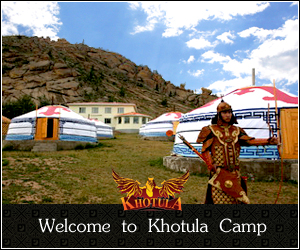Military Organization and The Thousandth System
Genghis Khan organized his army in divisions of tens. This system already existed between nomadic tribes at that time; one of ten leads others, ten tens were subject to the chief of a hundred, ten hundreds to the chief of a thousand, and ten thousands to the chief of ten thousand respectively. Strict discipline was enforced. If a head of ten failed to lead his ten, he was demoted and replaced with a new chief.
The Mongol was an exceedingly tough warrior. Raised on the harsh steppes of Mongolia, they were generally a short people, spending many hours on riding horses as children. They were used to privation and hardship, and were extremely dedicated. The Mongol always seemed to identify with his horse; the equally tough, hardy steppe pony. They were inseparable, the horse not only providing the means of transport into battle, but being very important to the Mongol steppe economy , providing milk, blood, and meat for food, hair and skin for clothing and tents, and glue and sinews for bow and arrow making. On the march, the Mongol warrior carried a string of ponies, rotating them as remounts to keep up the momentum of the advance. In a tight spot the Mongol would bleed selected ponies, using their blood to assuage his hunger. This extremely lean style of operation contributed to the rapidity of Mongol maneuvers. Typically, the Mongol was practical about his mounts and would discard or slaughter them as demanded by the situation without sentiment.
The Thousandth System
The Mongol military organization was based on the dividing of troops and units into groups of ten, hundred, thousand and ten thousand. Small groups of ten were considered to be like close knit families with one commander for each. In turn a group of ten tens, or a hundred had a single leader. Genghis drew from the pool of loyal and respected friends as the commanders for the groups of a thousand. His most trusted companions were given a group of ten thousand which is called a tumen. Genghis valued proven battlefield experience and loyalty and rewarded those who demonstrated it with important commanding positions.
In addition to his military, he also divided the state’s population into 95 groups of a thousand for administrative purposes. Chiefs, the most loyal nobles, were give groups of a thousand and were appointed by Genghis. These helped to strengthen his position and that of his successors and other nobles. Being a chief of a thousand granted the chief the right to control affairs of 1000 families within certain given area. This right was inherited through his successors . This was an appropriate way to organize nomadic living, herding and the levying of taxes.












